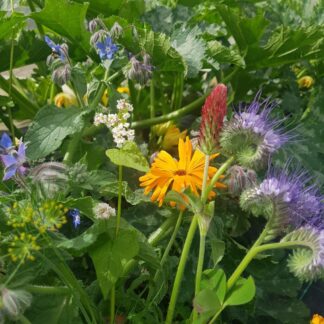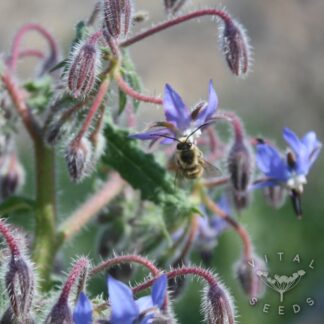Bee Mixture Seeds
How to grow Bee Mixture
How to grow Bee Mixture
Seed Sowing
Broadcast the seed in May – July onto well prepared soil. Rake in gently just to cover the seeds. Alternatively you can direct sow thinly in drills 30cm apart, allowing you to weed in between the rows.
To ensure bees and other pollinators have an abundant source of nectar and pollen throughout summer do a number of staggered sowings to maximise flowering time.
Transplanting
Bee Mixture works best if direct sown.
Plant Care
Keep the area weed-free and watered during hot spells. You can mulch around the plants to keep in moisture and prevent weeds. Deadhead to prolong flowering. Some of the taller growing plants in the mix may need support, especially in windy growing conditions.
Challenges
Having a dense mix of plants can create the perfect habitat for slugs and snails. If there isn’t enough ventilation between the plants you may also have problems with downy or powdery mildew so make sure to give plants enough space and keep weed free to reduce overcrowding.
Harvest
Ideally this mixture will be grown for bees and other beneficial insects, meaning it isn’t harvested and left for those creatures to forage. If you do want to bring some of the blooms indoors to enjoy, ideally harvest the flowers in the morning when temperatures are low and plant water content is high. Plants will arrange better if left to sit in water for a few hours after cutting.
Culinary Ideas
All flowers in this mixture apart from Phacelia are edible and make a delightful addition to salads, desserts or ice cubes with their pops of colour and delicate forms.
Growing calendar
| Month | J | F | M | A | M | J | J | A | S | O | N | D | ||||||||||||
|---|---|---|---|---|---|---|---|---|---|---|---|---|---|---|---|---|---|---|---|---|---|---|---|---|
| Sow | ||||||||||||||||||||||||
Showing the single result
-


Bee Mixture – (Organic)
£3.50 Add to basketBee Mixture – (Organic)
A colourful mixture of Borage, Buckwheat, Calendula, Crimson Clover, Cornflower, Dill, Coriander and Phacelia.. The bees and other beneficial insects in your garden will love this mixture of flowering plants. The nectar will provide them with sugar they need for energy and the pollen contains protein and oils that bees collect to raise the brood.
We rejoice in this bee mixture particularly as it has a diverse range of flowering plants and makes our vegetable plot look beautiful and filled with colour. The edibles amongst the mix we use to jazz up our summer salads.
(Approximate seed count – 5 grams) £3.50
£3.50
Showing the single result


